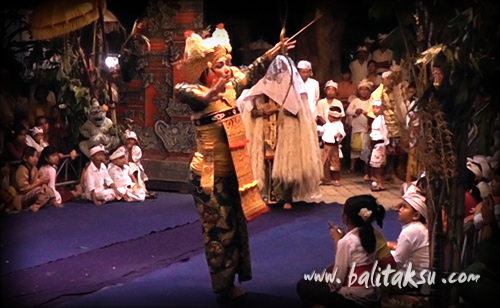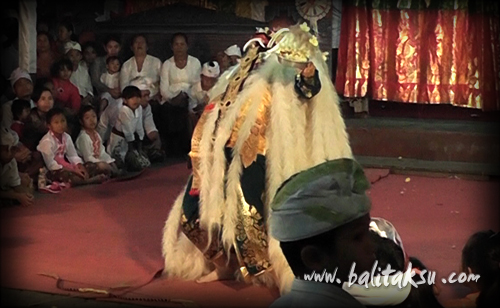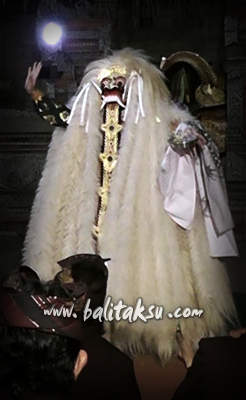Peliatan village since the 1920s has been known for its Legong Dance. One of the Legong that is known for its distinctive Peliatan is the Legong Semarandana. Although classified into rare dance performed, not just as Legong Lasem, the Legong Semarandana is classified into the dances that still preserved in Peliatan.

In one occasion m for the first time ever, had performed the Legong Semarandana in a temple ceremony at Pura Gunung Sari with gamelan group Dewi Sri Peliatan. In this dance, she acted as Ratih (Goddess of the Moon), with Teriasih, a dancer who is also from Banjar Kalah, who acted as Semara (God of Love).
At the ending of this dance, after dancing as Ratih, m switch roles appears again putting on the mask of she-devil, become Rangda (Shiva).

The Legong Semarandana tells the story of love and passion. Once, one of Raksasa (starved, beast-like giant tribes interior to man, with inbom power of demon), named Nilaludraka, was anxious to acquire the power to control this world and was practicing meditation. Siva descending onto this earthly world, was so impressed with his enthusiasm that she gave him the mighty power could be over come neither by gods nor man, except Siva and half-animal monster. Never experiencing any defeat, Nilaludraka continued challenging battles one after another, until there was none left in heaven and on earthy any more to compete with. All the gods flustered.

Unfortunately, Siva was devoted to meditation at the top of the Himalayas. No one could approach him, because his wrath may turn any one to ashes at once. Gods gathered and conceived a plan to send the son of Siva, Semara, to Himalayas as their envoy. Semara, in spite of his new bridge Ratih’s strong opposition, resolutely departed and Ratih followed him with tears. As they approach the Himalayas, the meditation of Siva was apparently disturbed. With rage, Siva laid Semara, Ratih and all in ashes in a moment.

Opening his eyes from meditation, Siva faced squarely to the ashes all over the world (thanks to this, it is said, man has love in this earth) Encourage by love of Semara, Siva and his wife Parwati got a child, half-animal monster who would conquer Nilaludraka.
The Story of Legong Semarandana
Semara a god of love and passion, is a son of Siva (an Indian god of destruction and dance). First coming on the stage are Semara and his new bride Ratih, a goddess of moon. Ratih dancer retreats to the backstage for one moment and appears again putting on the mask of shedevil, Rangda. Then the story begins. Once, one of Raksasa (starved, beast-like giant tribes interior to man, with inborn power of demon), named Nilaludraka, was anxious to acquire the power to control this world and was practising meditation. Siva descending onto this earthly world, was so impressed with his enthusiasm that she gave him the mighty power, which could ever be over come neither by gods nor man, except Siva and half animal monsters. Never experiencing any defeat, Nilaludraka continued challenging battles one after another, until there was none left in heaven and on earth any more to compete with. All gods were flustered.
Unfortunately, Siva was devoted to meditation at the top of the Himalayas. No one could approach him, because his wrath may turn any one to ashes at once. Gods gathered and conceived a plan to send the son of Siva, Semara, to the Himalayas as their envoy. Semara, in spite of his new bridge Ratih’s strong opposition, resolutely departed and Ratih followed him with tears. As they approach the Himalayas, the meditation of Siva was apparently disturbed. With rage, Siva laid Semara, Ratih and all in ashes in a moment. Opening his eyes from meditation, Siva faced squarely to the death of his son and wife. Lamenting for their unexpected death, Siva scattered the ashes all over the world (thanks to this, it is said, man has love in his hearth). Encouraged by love of Semara, Siva and his wife Parwati got a child, half-animal monster, who would conquer Nilaludraka.
